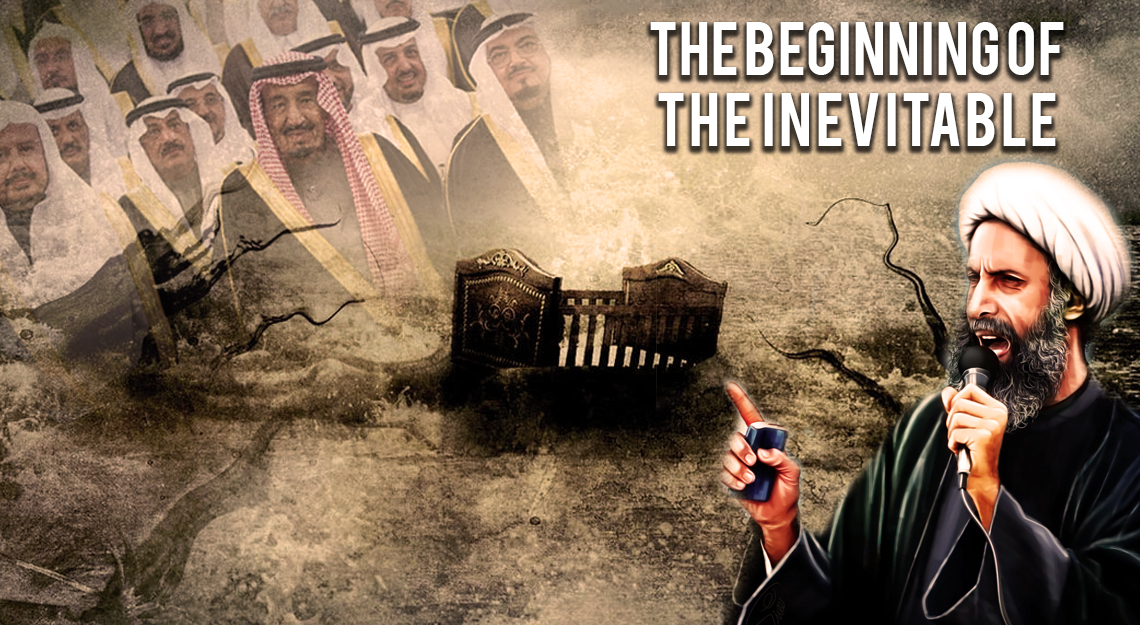
The Beginning of the Inevitable
The atrocities of the Saudi regime has earned it much notoriety in the last hundred years. Since their rise to power in the early 1920’s, the ruling family has shown no hesitation in torturing and killing any citizen who has dared to question their legitimacy – or lack thereof – as rulers of Saudi Arabia, a country formerly known as (and will be referred to henceforth as) the Hejaz. The most recent example of this ruthless, criminal dynasty’s brutality was two days into 2016, when it beheaded 46 people charged with terrorism and having links with Al-Qaeda. Among the 46 people executed was prominent Muslim cleric and dissident, Shaykh Nimr Baqir al-Nimr. Since January 2nd, when his execution was announced, the Saudi autocracy’s reputation has deteriorated further, and there have been renewed calls around the world for its downfall.
Shaykh al-Nimr, a reformist who believed in bringing a change to the tyrannical establishment that currently rules the Hejaz, was born and raised in the oil-rich settlement of Qatif, He had been vocal about the mistreatment of minorities in the Kingdom and demanded the government recognize the rights of the Shi’a. He had been arrested multiple times for voicing his opinion against the Saudi regime. When he was released in 2008, he was banned from speaking in public. The widespread revolts and revolutions in 2010 that took place in West Asia marked the beginning of the Islamic Awakening. Saudi Arabia was also affected: unarmed, peaceful demonstrators, led by Shaykh al-Nimr (who was becoming increasingly outspoken and his speeches, increasingly fiery), took to Qatifi streets to demand their rights. Shaykh al-Nimr publicly condemned the government’s imprisonment of dissidents without charge, and pledged his support for political prisoners until they received a fair trial.
The Saudis, threatened Shaykh al-Nimr’s increasingly vocal criticism, feared that unrest in Qatif would lead to the same results as in Egypt, Tunisia, and Libya (that is, change of government and political system). Resorting to methods that were successful in the past, the Wahhabi government sought to suppress the uprising. In 2012, Shaykh al-Nimr was shot, arrested, and imprisoned. His arrest generated widespread outrage and opposition, and there were frequent calls for his release until his execution, before which there were reports of him being tortured in prison. Despite protests, however, the Saudi regime ignored all calls for the Shaykh’s release. On the 15th of October, 2014, Shaykh Nimr Baqir al-Nimr was sentenced to death for “disobeying” the rulers of Saudi Arabia and “taking up arms against the security forces” by a judge who refused to grant him his request for a pen. Demands for his release increased international pressure on the Saudi government, but these demands were ignored. On January 2nd, 2016, Shaykh al-Nimr, the revolutionary dissident cleric of Hejaz was beheaded and his corpse was thrown from a building. Saudi Arabia had created a martyr.
A martyr’s blood is never wasted. Shaykh al-Nimr, who sacrificed everything to expose the true face of the Saudi royal family, highlighted and publicized the regime’s well-documented relationship with the United States. America, the so-called champion and flag-bearer of democracy and self-proclaimed “leader of the free world” has consistently remained mute over Saudi atrocities in the rest of the world as well as the Middle East, and, following Shaykh al-Nimr’s beheading, maintained its policy of refusing to condemn Saudi terrorism.
Shaykh al-Nimr’s execution – and the events that followed – lead us to several conclusions. After the execution, two Saudi embassies in Iran were set aflame. Despite the fact that the torching of the embassies was condemned by the Islamic Republic, and the 40 culprits behind the act were swiftly arrested, the Saudis used the event as an excuse to sever ties with Iran. Compare Iran’s reaction after the torching of the Saudi embassies to the Saudi reaction following the molestation of two Iranians by the Kingdom’s security personnel: there was no acceptance of blame or condemnation by the Saudi establishment. Furthermore, the Saudis refused to hold themselves accountable for the badly organized Hajj pilgrimage of 2015, which led to a stampede that killed more than 400 Iranian nationals.
The current situation in the Middle East and the world is grim: something that America and the illegitimate Zionist entity occupying Palestine has been longed for and planned for years. The American-Zionist plot to instigate an uninhibited, sectarian war in the Muslim world might bear fruit if the Saudi establishment refuses to take proper steps to avoid it. One thing that the Saudi regime did before executing Shaykh al-Nimr was to form a 34-state coalition to “fight terrorism”. This measure may seem genuine, but it is not. It has been proven time and again that Saudi Arabia is the biggest financer, producer, and primary cause of global terrorism. This 34-state coalition was not created for the sake of battling global terrorism, but in order to establish an anti-Iran alliance. Saudi Arabia was not the only country that severed ties with Iran after Shaykh al-Nimr’s beheading; other countries in the region have also either severed their ties with or shown their hostility towards the Islamic Republic. It seems as though things are shaping up exactly the way the Zionist-American alliance has hoped for, and we might be entering the first phase of an all-out war between a Saudi-US led coalition against Iran. What is certain is that Saudi Arabia will soon be faced with holy vengeance for shedding the blood of an innocent man that will inevitably lead to their downfall.







